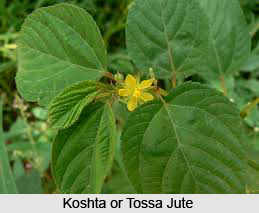 Koshta has a scientific name of Corchorus olitorius. It has many common names attached to it in different Indian languages. In Bengali it is known as banpat. In Gujarati it is known as chhunchho. In Hindi it is known as koshta and pata. In Marathi it is known as chunch and motichunch. In Oriyait is known as jhoto or kaunria. In Punjabi it is called ban-phal. In Tamil it is called as peratti. In Telegu it is known as parintakura.
Koshta has a scientific name of Corchorus olitorius. It has many common names attached to it in different Indian languages. In Bengali it is known as banpat. In Gujarati it is known as chhunchho. In Hindi it is known as koshta and pata. In Marathi it is known as chunch and motichunch. In Oriyait is known as jhoto or kaunria. In Punjabi it is called ban-phal. In Tamil it is called as peratti. In Telegu it is known as parintakura.
It is an erect herb with slender stems. It is 60-120 cm tall. The Leaves are 6.3-10 cm long and 3.8-5 cm wide. Its flowers are pale yellow which is seen between the months of July and November. Purplish streaks are seen along the grooves. Its seeds are trigonous.
It is pan tropical in distribution. This herb is commonly found in fields and forest. It is also cultivated at times particularly in West Bengal.
The leaves are soft, refresher and diuretic. This herb is used for the treatment of chronic cystitis, dysuria and gonorrhoea. A cold infusion of the dried leaves is used as a bitter tonic which is given to patients who are recovering from acute dysentery. This restores their appetite and strength. In Ayurveda the leaves are used to treat abdominal tumours and piles. The dried, roasted, powdered plant is also used to treat visceral obstructions.
This article is a stub. You can enrich by adding more information to it. Send your Write Up to content@indianetzone.com.



















